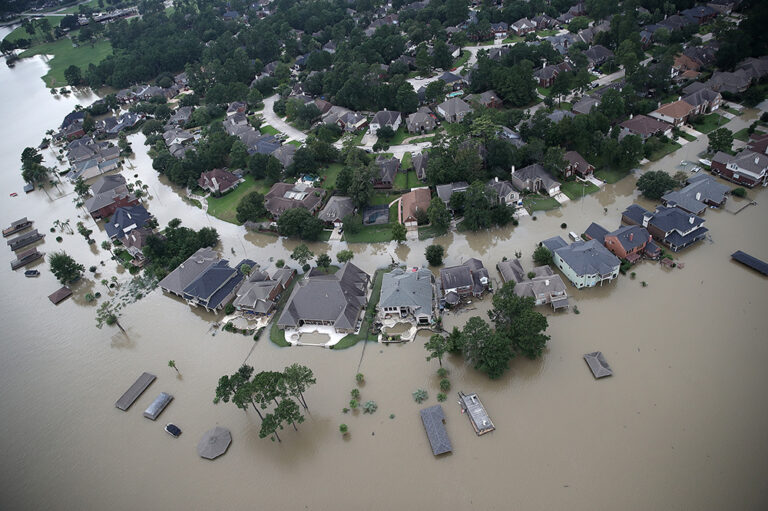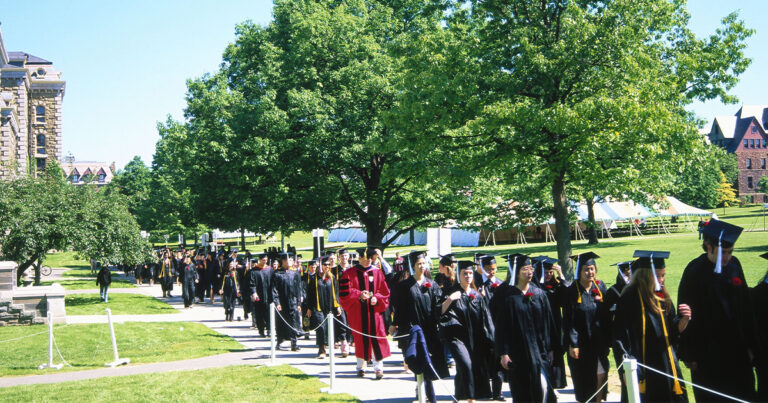Access to high-speed internet, known as broadband, has become increasingly important as more day-to-day activities move online. Indeed, broadband internet has become a necessary underpinning of our society and economy, to the degree that many consider it essential infrastructure. The pandemic underscored that shift as many workers were required to telecommute and students shifted to remote learning. However, many Americans living in rural areas have limited access to broadband infrastructure. In other areas, broadband access is limited by socioeconomic factors and contributes to the digital divide — the gap between those with ready access to computers and the internet, and those without.
Although most broadband services are provided by private-sector companies, the federal government plays an oversight role in the provision of broadband and provides funding through programs at the Rural Utilities Service of the Department of Agriculture and the Universal Service Fund under the Federal Communications Commission (FCC). To further assist in closing the digital divide, several states have been developing broadband programs and initiatives. This blog provides an overview of the various efforts to expand broadband access and their implications for the federal budget.
Access to the 21st Century
Internet usage has increased significantly since becoming widely available in the 1990s, but millions continue to lack broadband access. Broadband is critical for a range of uses including job applications, education, telehealth services, and civic engagement. By the end of 2019, 14.5 million Americans, or about 4.4 percent of the population, lacked broadband access according to the FCC. An independent estimate by BroadbandNow, a group that collects data on internet providers in the United States, puts that figure closer to 42.0 million. The two estimates vary in the definition of access to broadband service. The FCC collects access information twice per year from internet service providers (ISPs) and reports an entire census block fully serviced even if just one household in the block has broadband access. BroadbandNow’s estimates are informed by verifying access at addresses where service is available according to FCC’s data.
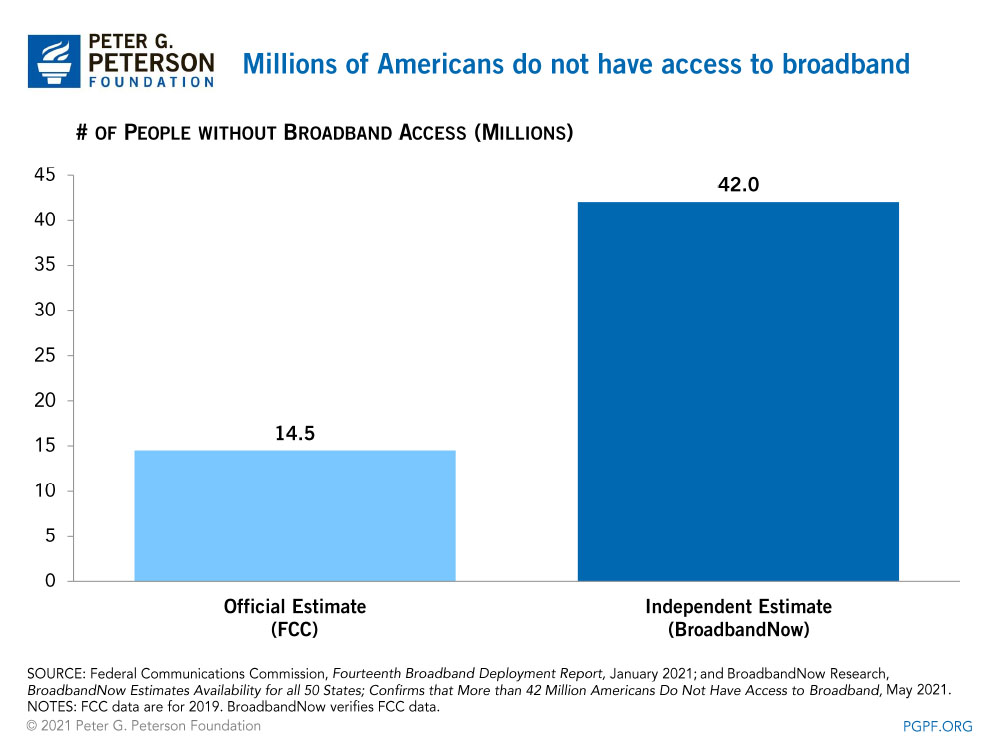
Lack of access to infrastructure is a key barrier preventing households from adopting and incorporating broadband into everyday activities, especially in sparsely populated regions. For example, private capital investment is lower in rural areas because lower household density does not yield the revenues necessary to justify up-front costs. As a result, the share of rural households with a broadband subscription (80.8 percent) is lower than the share of urban households (86.1 percent), according to Census Bureau data for 2018, the most recent available. Based on that data, however, there are roughly three times as many urban households without a broadband subscription than rural households.
Socioeconomic factors including income, education, race, and age can also affect whether households adopt broadband. For example, younger Americans and those with higher levels of education are more likely to have strong digital skills and rely on a broadband subscription for school and work. Moreover, homeowners and households with children are more likely to maintain a broadband subscription. However, income is the greatest determinant. For example, low adoption rates in some communities can be attributed to limited market competition, which results in prohibitive costs to consumers.
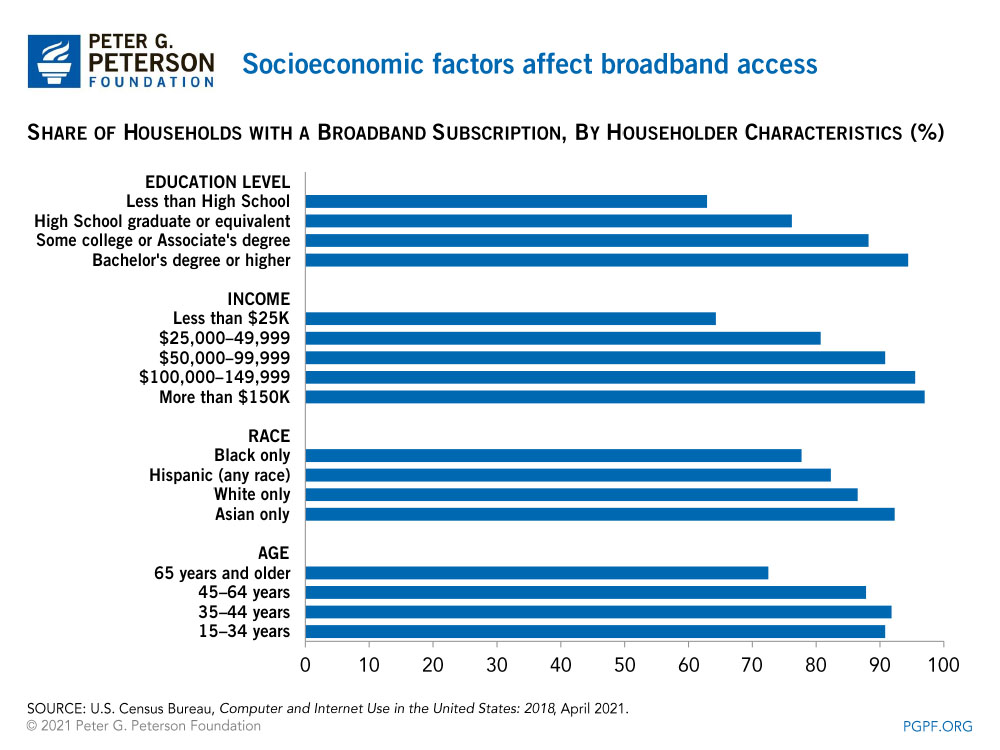
Public vs. Private Investment
Broadband infrastructure is primarily financed by the private sector. A 2020 Government Accountability Office report found that from 2009–2017, federal investments totaled $47 billion, while the industry made $795 billion in capital investments. Investments have included spending for fixed and wireless infrastructure as well as government efforts to map the gaps in access. The Telecommunications Act of 1996 charges the federal government with ensuring the reasonable and timely deployment of broadband infrastructure to bridge the digital divide. As such, the federal government plays an oversight role and provides limited funding for groups not well served by the private sector, including low-income households, schools and libraries, and rural areas.
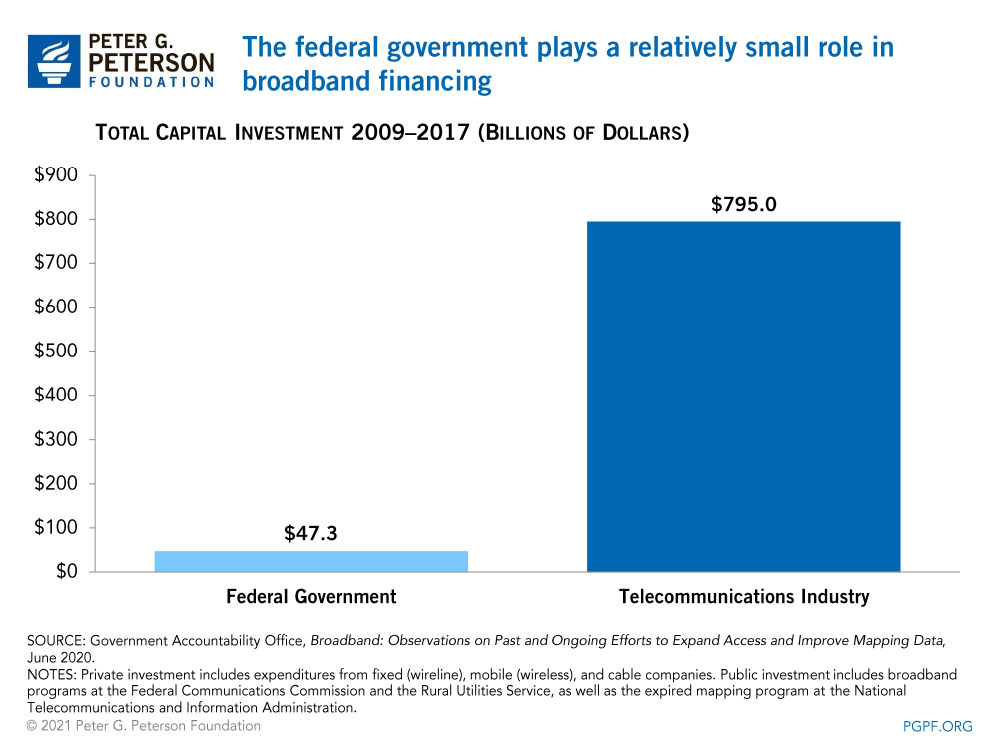
Investments in broadband produce a range of economic and social benefits, according to the Brookings Insitution. For example, increasing access to broadband can result in higher property values, a greater number of jobs, and lower unemployment. Moreover, broadband unlocks access to remote healthcare providers and educational opportunities, which can improve health and life outcomes.
Federal Broadband Programs
Federal broadband funding flows through various grant and loan programs under the Universal Service Fund (USF) and the Rural Utilities Service (RUS).
FCC’s Universal Service Fund
The concept of universal service was initially intended to ensure access to voice telephone service, but in recent years, it has expanded to include broadband. USF encompasses four programs:
- The Connect America Fund provides support for eligible ISPs to help offset the higher-than-average costs of providing service in rural and other high-cost areas. In 2019, the FCC expanded the program to include the Rural Digital Opportunity Fund, which will target entirely unserved census blocks.
- The E-rate program provides support for eligible elementary and secondary schools, as well as libraries, for internet access.
- The Lifeline program subsidizes broadband costs for eligible low-income consumers.
- The Rural Health Care program provides support to eligible rural healthcare providers for broadband services.
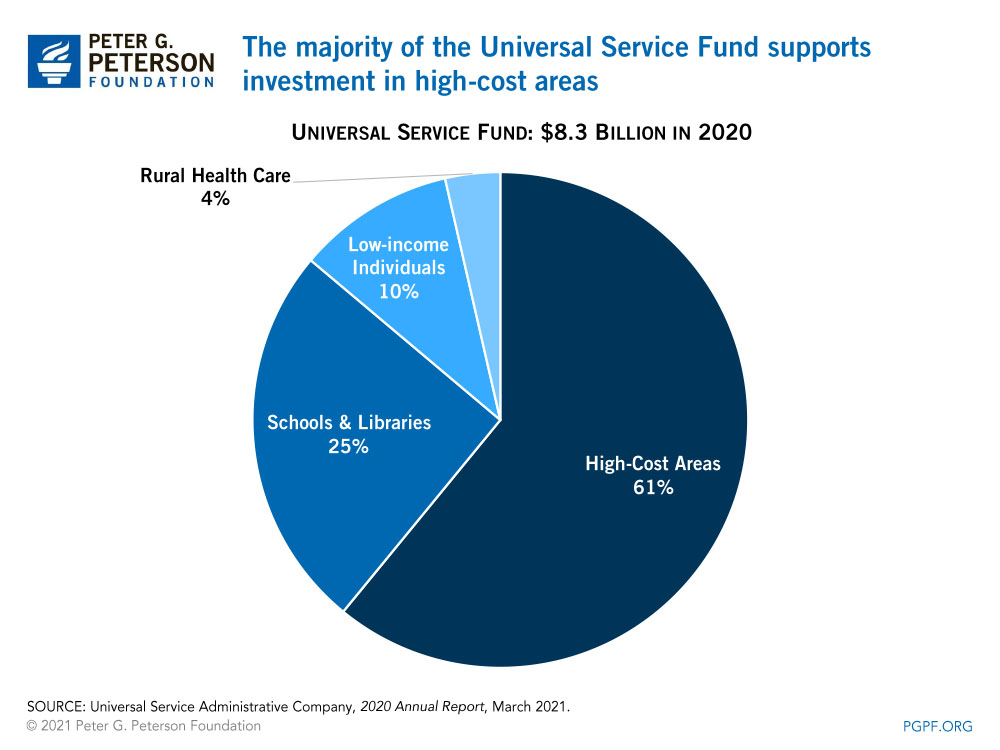
USF receives no federal appropriations; instead, telephone service providers must pay a percentage of their interstate and international revenues to the fund, which is known as the contribution factor. The FCC adjusts the contribution factor four times per year depending on the needs of the universal service programs. For years, such revenues have been declining as consumers switch to internet-based alternatives that do not pay into the fund. As a result, the FCC has repeatedly increased the contribution factor. In the first quarter of 2021, the contribution factor was 31.8 percent of revenues, up from 6.8 percent in the first quarter of 2002. As the revenue base declines, lawmakers will be challenged to address the fund’s sustainability.
USDA’s Rural Utilities Service
The Telecommunications programs at RUS provide assistance to improve broadband access in eligible rural areas. Eligibility criteria vary, with some programs targeting unserved areas and others available to underserved areas. Congress provides funding for RUS through the annual appropriations process to administer four programs:
- The Telecommunications Infrastructure Loans and Loan Guarantees finances projects in rural areas with a population of 5,000 or less.
- The ReConnect Program provides loans and grants to cover broadband costs in rural areas with the least access, defined as 90 percent of households lacking speeds that are less than half of the FCC’s current standard. ReConnect also encompasses the Rural Broadband Access Loan Program, which finances the construction and improvement of facilities to provide service.
- The Distance Learning and Telemedicine Grant program covers the cost of equipment to help rural users connect to teachers and medical service providers.
- The Community Connect Grants program funds deployments in rural communities where it is not yet economically viable for the private sector to deliver service.
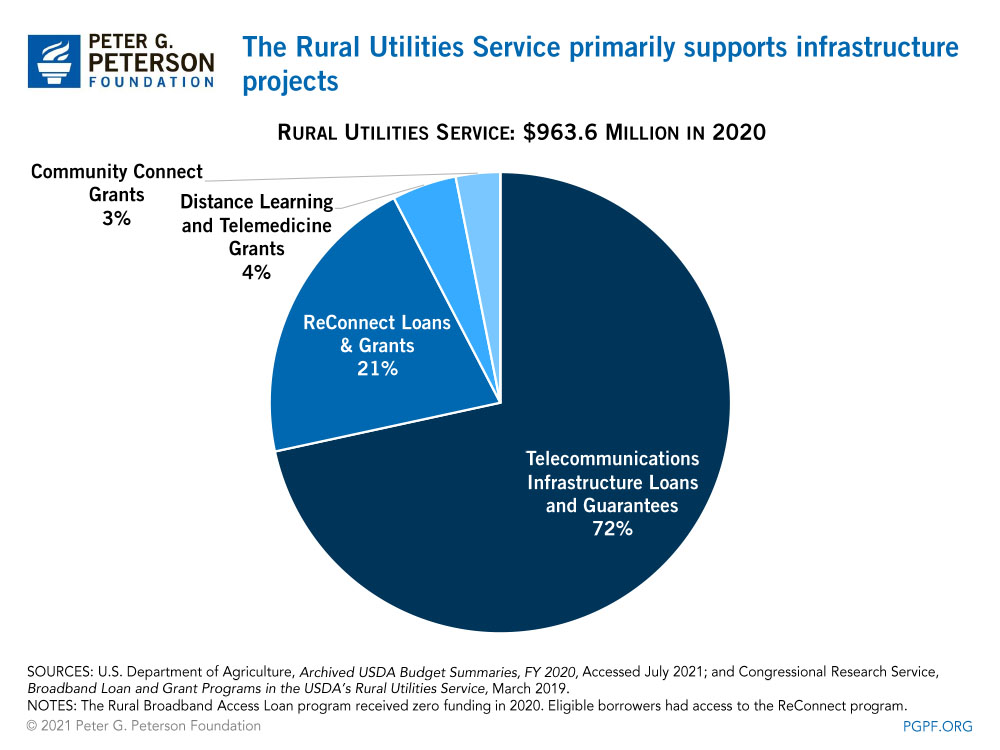
Federal Initiatives and Proposals during COVID-19
The pandemic underscored the critical need for broadband and motivated several initiatives to reduce costs for users and provide emergency access. Altogether, Congress appropriated about $15 billion for broadband programs during the pandemic. Recent proposals aim to extend such programs as well as provide additional federal aid for infrastructure deployment.
COVID-19 Telehealth Program and Emergency Broadband Benefit
On March 27, 2020, the Coronavirus Aid, Relief, and Economic Security Act established the COVID-19 Telehealth program with an initial $200 million in funding. Funds have been used to reimburse providers for services and equipment used to deliver telehealth during the pandemic. On December 27, 2020, the Consolidated Appropriations Act (CAA) appropriated an additional $250 million to the program.
CAA also provided tribal entities with $3.7 billion for infrastructure deployment, broadband programs, and service subsidies. Moreover, CAA established the $3.2 billion Emergency Broadband Benefit to help Americans afford internet service during the pandemic. Until funds have been exhausted, that program will provide a monthly $50 subsidy for internet service and a one-time $100 subsidy for devices. Eligible households include those below 135 percent of the federal poverty line, households that have experienced a substantial loss of income due to the pandemic, or that have members eligible for reduced-price school lunches, SNAP, or Medicaid.
Other CAA funding has been targeted to address access in underserved areas, replacing infrastructure that poses a national security risk, and mapping access.
Emergency Connectivity Fund
On March 11, 2021, the American Rescue Plan provided $7.2 billion to establish the FCC’s Emergency Connectivity Fund. That program helps schools and libraries provide off-campus broadband service for students and staff during the pandemic. In addition, the program covers the reasonable costs of equipment including modems, routers, and devices.
Infrastructure Package Proposal
In the latest example of policymakers seeing broadband internet as a national economic priority, the bipartisan infrastructure package that recently passed the Senate would allocate $65.0 billion for investment to expand broadband access. The bill earmarks $42.5 billion for projects targeted to remote and underserved areas through a new Broadband Equity, Access, and Deployment program housed in the National Telecommunications and Information Administration. In addition, it allocates $14.2 billion to extend the Emergency Broadband Benefit — which would be renamed as the Affordable Connectivity Fund — so that eligible households receive $30 in monthly subsidies for internet access and a one-time grant of $100 for devices.
State and Local Initiatives Address Key Issues
To ensure that households have broadband access, some state and local governments have also implemented programs to address a range of issues including the homework gap, infrastructure deployment, adoption, and broadband mapping.
The Homework Gap
While many schools assign homework online, some students have a difficult time completing such tasks because they lack broadband access — a problem known as the homework gap. The National Education Association finds that 25 percent of all school-aged children live in households without broadband access or a web-enabled device. As a result, students have resorted to completing homework through public Wi-Fi spots in parking lots.
To help address the homework gap, in 2016, Caldwell County, North Carolina piloted one of the first programs to equip school buses with Wi-Fi access. In addition, the program provides laptops for students to use while commuting. When buses are not transporting children, the buses are parked in key areas to enable access to high-speed internet for local residents.
Infrastructure Deployments
To supplement federal efforts, some state governments provide grant funding for deployment projects. For example, in 2015, New York established a $500 million broadband program that awards funds in a reverse auction similar to FCC’s Rural Digital Opportunity Fund. New York’s program intends to deliver speeds to unserved or underserved areas at four times the federal standard.
Broadband Adoption
In areas where service is available, a major contributor to the digital divide is broadband adoption. Such adoption is affected by several factors including subscription costs, digital literacy (familiarity of devices), and awareness of the benefits broadband can unlock. To address such issues, in 2017, California established its Broadband Adoption Fund, which has been fully awarded as of June 2021.
The $20 million program provided grants to communities with low adoption rates to increase publicly available broadband access and funding for digital literacy training programs. The program gave preference to low-income communities and communities with high concentrations of older Americans.
Mapping Access
Mapping broadband access is a complex challenge that determines where service providers and governments invest resources to expand and improve access. Current FCC maps consider a census block served if at least one household or business in that census block has broadband access.
To address that challenge, in 2018, Georgia piloted a program in three counties to verify access in individual households in partnership with service providers and county officials. Unlike the FCC’s approach, Georgia’s program considers a census block unserved if at least 20 percent of households do not have access. The program completed the mapping effort in June 2020 and it revealed that the FCC misidentified half of Georgia’s locations without broadband.
Conclusion
Broadband is an indispensable tool for aspects of everyday life such as employment, education, and healthcare. As a result, federal policymakers have prioritized funding it because they view investments in this area as critical to modernizing the nation’s infrastructure, expanding economic opportunities, and maintaining a competitive edge globally. While the COVID pandemic has motivated additional investments, it remains to be seen the extent to which such funding will help close the digital divide.
Image credit:
Further Reading
Budget Basics: The National Flood Insurance Program
The National Flood Insurance Program is run by the federal government to reduce the impact of flooding on private and public structures.
Why Did the Federal Government Get Involved in Student Loans?
Skyrocketing student debt has generated significant discussion about ways to improve the financing of higher education in the United States.
How Do Federal Student Loans Affect the National Debt?
Student debt held has been steadily increasing ever since the federal government switched to direct lending.
